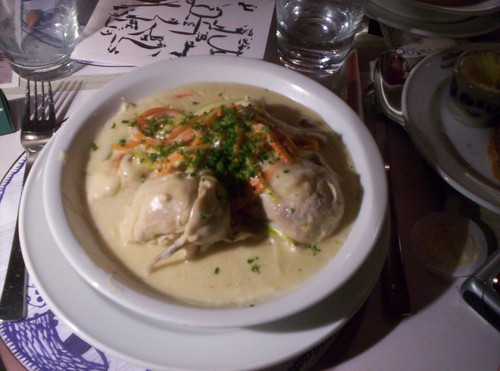Friday, February 01, 2008
Belgian Waterzooi and Witloof
 As most of you know, my wife and I have been in Belgium for the last several months and have been doing some traveling within Europe, and of course, sampling local dishes as we go along. I thought I'd deviate slightly from the Bangalore centric nature of my blog to write about two lovely Belgian dishes I've been fortunate to have tried - Waterzooi and Witloof.
As most of you know, my wife and I have been in Belgium for the last several months and have been doing some traveling within Europe, and of course, sampling local dishes as we go along. I thought I'd deviate slightly from the Bangalore centric nature of my blog to write about two lovely Belgian dishes I've been fortunate to have tried - Waterzooi and Witloof.We ate dinner at the famous brasserie Au Vieux Saint Martin, which is located in Place du Grand Sablon, nearby world famous chocolate maker Pierre Marcolini and the confectioner's Wittamer.
Waterzooi, captured by my wife in the picture below is a "a traditional Flemish soup come stew which was originally prepared with freshwater fish and vegetables but the best known version is with chicken. Waterzooi also works well with a variety of seafood or with rabbit.", according to BareIngredients.
Chicken Waterzooi |
- 2 large carrots
- 2 medium onions
- 2 tender ribs of celery
- 2 medium-sized leeks, white and tender green parts only
- 1/2 teaspoon dried tarragon
- Salt and freshly ground white pepper to taste
- 2 1/2 pounds cut-up frying chicken, legs or thighs or breasts (with bone), or a mixture of these
- 1 1/2 cups dry white French vermouth
- 1 1/2 to 2 cups chicken broth
- 1/2 cup heavy cream
- 1 1/2 teaspoons cornstarch
- 6 egg yolks
- 3 tablespoons minced fresh parsley.
- Trim and wash the vegetables and cut them into julienne matchsticks one and three-quarters inches long and one-eighth inch wide. (This should come to about five cups in all.) Toss them in a large mixing bowl with the tarragon and a sprinkling of salt and pepper.
- Wash and dry the chicken pieces and set aside.
- Using a casserole large enough to hold the chicken and the vegetables comfortably, layer in the following order: one-third of the vegetables, half of the chicken, half of the remaining vegetables, the rest of the chicken and the remaining vegetables. Pour in the vermouth and enough chicken broth to barely cover the chicken. Up to this point, the recipe may be prepared several hours in advance. Cover and refrigerate.
- When ready to cook, bring to the simmer, covered, and cook slowly 25 to 30 minutes or until the chicken pieces are tender and, when pierced, the juices run clear.
- Strain out the cooking liquid, degrease it and adjust the seasonings.
- Blend the cream and cornstarch in a small mixing bowl. Whisk the egg yolks in a large bowl and stir in the cream mixture. Slowly whisk in the hot cooking liquid. Pour the sauce over the chicken. Set over medium-low heat, swirling the casserole gently, until the sauce is warmed and thickens slightly, but do not bring to the simmer or the egg yolks will curdle.
- To serve, ladle the chicken, vegetables and sauce into large warm soup bowls and sprinkle each serving with parsley.
- Serve with boiled potatoes, noodles, gnocchi or just good French bread.
Yield: Four to six servings.
I've tried waterzooi several times in Belgium and it has never disappointed - hope you enjoy it!
As for Witloof, my experiences have been a bit mixed, but I was not disappointed at the Au Vieux Saint Martin. Here's a bit of history on Witlook from a blog online:
Legends and facts :
1830 Schaarbeek (nr Brussels). A man called Jan Brammens, who was one of the many farmers, who had to escape from the violence in Brabant, before the independence of Belgium. Before he left, he quickly cut some chicory roots for his surrogate coffee. He threw them in his cellar and to prevent them from drying out he covered them with some soil. When he arrives back at his farm he discovers that the roots had sprouted many conical blanched hearts, which to his mind tasted very nice indeed.
A more accepted version however is about Franciscus Bresier, who worked at the Royal Gardens 'Botanieken Hof' or Kruidtuin'. Planning to grow loose leaved chicory, he kept the roots stacked one closely next to the other in the mushroom cellars and covered them with composted down horse manure. He also watered them regularly to give the plants a head start for when he wanted to plant them out.
To his amazement he noticed the blanched hearts that looked like Roman lettuce appearing on the roots.
During the next two years he did a trial with roots , covered with soil and roots that he left uncovered. Again, the covered roots produced this lovely vegetable.
The 1834-1835 winter is to be the official year that chicory or 'witloof', as we know it now, was discovered.
The way the chicory got out and famous is still a mystery, but a fact is that the first harvest made it's way to the market in Brussels in 1846. From 1840 till then the growing of chicory was a public secret that more and more farmers tended to cultivate. The cultivation then spread to the rest of Flanders, to the Netherlands and France.
Witloof with mashed potatoes |







No comments yet